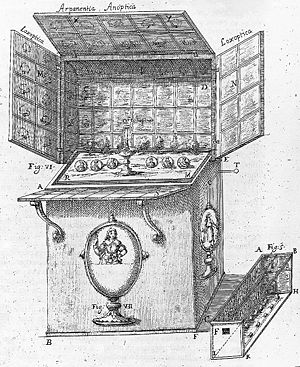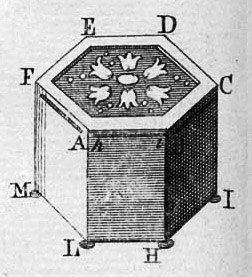
Catoptric cistula
Encyclopedia

Mirror
A mirror is an object that reflects light or sound in a way that preserves much of its original quality prior to its contact with the mirror. Some mirrors also filter out some wavelengths, while preserving other wavelengths in the reflection...
s, so as to magnify or multiply images of any object placed inside the box. Of these, there are various kinds for various purposes, such as magnification, deformation, or multiplication of images.
The most elaborate catoptric chests known from Ancient Rome
Ancient Rome
Ancient Rome was a thriving civilization that grew on the Italian Peninsula as early as the 8th century BC. Located along the Mediterranean Sea and centered on the city of Rome, it expanded to one of the largest empires in the ancient world....
exhibited detailed scenes, including expansive libraries, forests, cities, or even vast treasures. Another form of entertainment involved placing an animal, such as a cat, inside a chest, and watching it interact with numerous other cats that appeared to surround it.
Multiple scenes in one chest

Catoptrics
Catoptrics deals with the phenomena of reflected light and image-forming optical systems using mirrors. From the Greek κατοπτρικός ....
cistula to represent several distinct scenes of objects, when looked in through several holes. Provide a polygonous cistula, or chest, in the shape of a multilateral prism ABCDEF, as shown in the figure, and divide its cavity by diagonal planes EB, FC, DA, intersecting each other in the center G, into as many triangular cells as the chest has sides; for example, a hexagonal chest will have six cells. Line the diagonal planes with plane mirrors. In the lateral planes, make round holes, through which the eye may observe cells of the chest. The holes are to be covered with plain glass, ground on the inner side, but not polished, to prevent the objects in the cells from appearing too distinctly. In each cell are placed the different objects, whose images are to be exhibited; then covering up the top of the chest with a thin transparent membrane, to permit light, the apparatus is complete.
By the laws of reflection
Reflection (physics)
Reflection is the change in direction of a wavefront at an interface between two differentmedia so that the wavefront returns into the medium from which it originated. Common examples include the reflection of light, sound and water waves...
, the images of the objects, placed within the angles of the mirrors, are multiplied, and some appear more distant than others, so that the objects of one cell will appear to take up more space than is contained in the entire chest. Looking through each hole will produce a new scene, each seemingly too large to be contained in the chest. According to the different angles the mirrors make with each other, the representations will be different; if the mirrors are at an angle greater than a right one, the images will be immense. (see anamorphosis
Anamorphosis
Anamorphosis or anamorphism may refer to any of the following:*Anamorphosis, in art, the representation of an object as seen, for instance, altered by reflection in a mirror...
)
One large scene

Following is an explanation of the construction of a catoptric cistula to represent the objects within it prodigiously multiplied, and diffused through a vast space. Make a polygonous chest, as before, but without dividing the inner cavity into any apartments or cells; see the second figure for an example. Line the lateral planes CBHI, BHLA, ALMF, etc, with plane mirrors, and at the apertures, scrape off the tin and quicksilver of the mirrors, so that the eye can see through. Place any objects in the bottom MI, e.g. a bird in a cage, etc.
Here, the eye looking through the aperture h i, will see each object placed at the bottom, vastly multiplied, and the images separated by equal distances from one another.
In culture
The torture chamberTorture chamber
A torture chamber is a room where torture is inflicted.- Methods of coercion :According to Frederick Howard Wines in his book Punishment and Reformation: A Study Of The Penitentiary System there were three main types of coercion employed in the torture chamber: Coercion by the cord, by water and...
in the Phantom of the Opera is a six-sided catoptric chamber:
The TARDIS
TARDIS
The TARDISGenerally, TARDIS is written in all upper case letters—this convention was popularised by the Target novelisations of the 1970s...
of the television series Doctor Who
Doctor Who
Doctor Who is a British science fiction television programme produced by the BBC. The programme depicts the adventures of a time-travelling humanoid alien known as the Doctor who explores the universe in a sentient time machine called the TARDIS that flies through time and space, whose exterior...
is perhaps a modern expression, though fictional, of the effect sought to be created in the mind of the viewer of a catoptric chamber.
Jorge Luis Borges
Jorge Luis Borges
Jorge Francisco Isidoro Luis Borges Acevedo , known as Jorge Luis Borges , was an Argentine writer, essayist, poet and translator born in Buenos Aires. In 1914 his family moved to Switzerland where he attended school, receiving his baccalauréat from the Collège de Genève in 1918. The family...
's Library of Babel
The Library of Babel
"The Library of Babel" is a short story by Argentine author and librarian Jorge Luis Borges , conceiving of a universe in the form of a vast library containing all possible 410-page books of a certain format....
is a universe which really is organised as an infinite matrix of repeating units, as it appears to be from the inside of a catoptric chamber.

